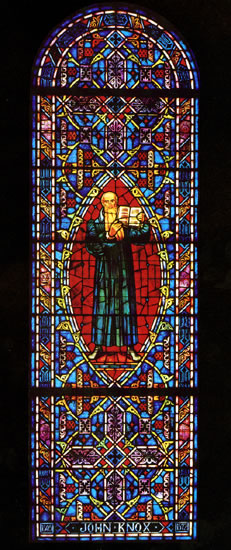
His conversion to Protestantism was brought about because of the influence of two men, Thomas Guillanne and George Wishart. Knox became an ardent follower of Wishart and wanted to die with him as a martyr, but Wishart advised him to continue teaching in the reform movement. He became the minister of the First Church of St. Andrews, and it was while serving there that he was imprisoned and forced to spend 19 months as a galley slave. The servitude permanently injured his health and, after his release in 1549. he was unable to return to Scotland. He ministered in exile for nearly 10 years, five of which he served in the Church of England.
While it seems strange that the “Father of the Presbyterian Church in Scotland” was a minister in the Church of England, from Knox’s point of view it was an opportunity to serve. During the period, King Edward VI of England was very tolerant toward the reformers. Knox was appointed as one of the common Chaplains to the king, helping to approve the Articles of Religion that later became the Thirty-nine Articles of the Church of England.
In 1554, after the death of Edward VI, Knox proceeded to the continent and met John Calvin in Geneva. In Geneva, he became minister of the English church and continued his association with Calvin until he left for Scotland in 1560.
When the reformed religion was formally ratified by law in Scotland, Knox became minister of St. Giles, a great parish church in Edinburgh. It was the beginning of this most influential ministry. During the next five or six years, he completed a work, the History of the Reformation. During his service at St. Giles, he enjoyed a comfortable home and a moderately good salary. Knox died at the age of 67 on Nov. 24, 1572.
The left side border symbols of the Knox window, numbered from top to bottom, are: 1. a Greek cross, also called the Cross of St. George, with arms of equal length carrying out the Greek concept of perfect beauty and symmetry, representing the death of Christ; 2. a crown indicating the rulership of the “King of Kings,” Christ as Lord; and 3. the shield of St. John with a serpent in a cup symbolizing the legend about an attempt to kill St. John by poisoning. Tradition said that the priest of Diana gave him poisoned wine to drink, but when he made the sign of the cross, the poison escaped from the cup in the form of a serpent.
The right side border symbols of the Knox window, numbered from top to bottom, are: 1. seven doves as the seven gifts of the Holy Spirit, traditionally: wisdom, understanding, counsel, might, knowledge, fear, and justice (Isiah 11:2-4) (cf. John Calvin Window, border right 3.); 2. a 10-pointed star representing the 10 disciples who neither denied nor betrayed Jesus (omitting Peter and Judas) or the Ten Commandments; and 3. an anchor symbolizing hope as an anchor of the soul (Hebrews 6:19).














